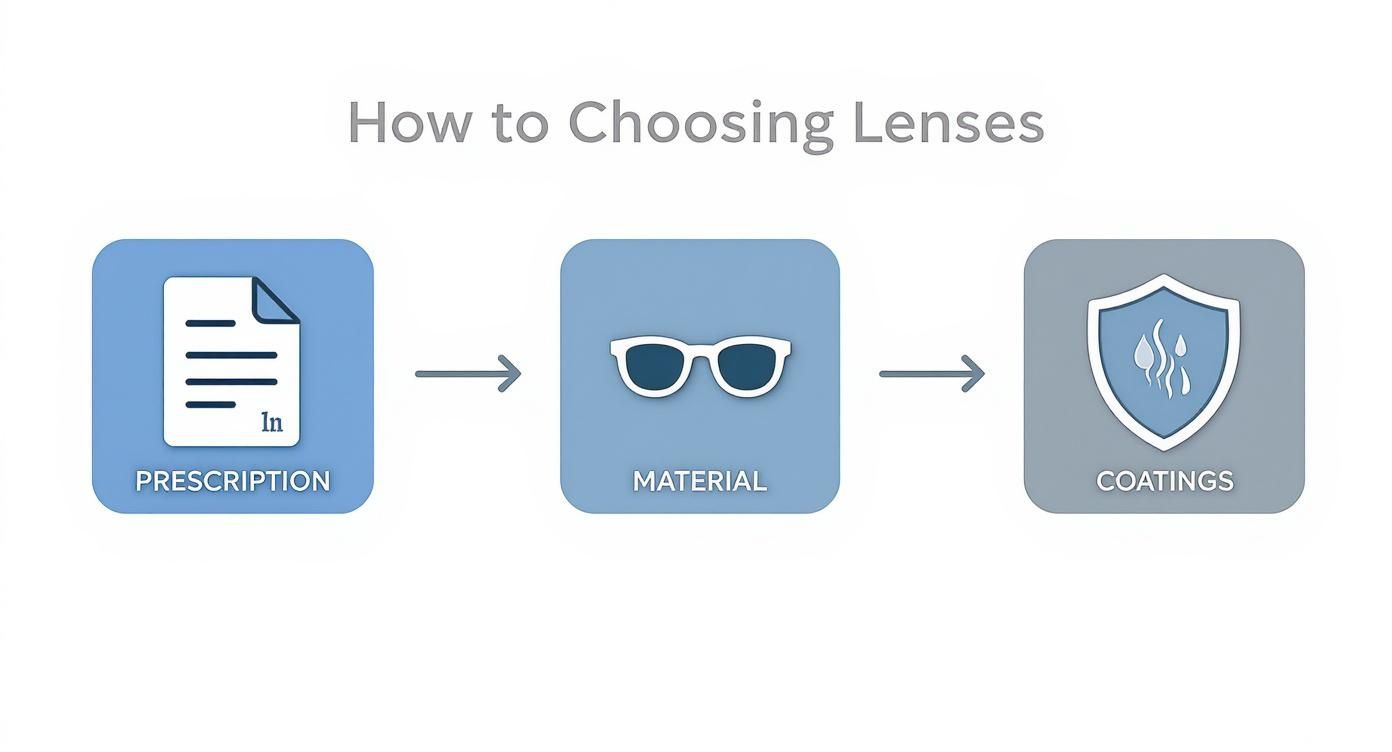Finding prescription glasses online at bargain prices can shave hundreds off your eyewear bill—all from the comfort of your couch. We can customise an eyewear package to suit your requirements, whether you need multiple pairs for different environments or a single versatile set. For example, a shift worker who toggles between computer work and night shifts can bundle a blue-light-filter pair with a low-light-optimized lens.
It all boils down to three simple moves: secure a fresh prescription, pinpoint a trustworthy retailer, then pick frames and lenses that suit both your style and your budget.
How To Safely Buy Glasses Online And Save Money
Shopping for eyewear in cyberspace unlocks a treasure trove of options. You’re no longer confined to the handful of frames your local store stocks. Instead, you can browse thousands of shapes, colours and materials across multiple websites—and thanks to fierce competition, prices stay delightfully low.

Consider this: Australia’s Online Eyeglasses and Contact Lens Sales market is forecast to hit AUD 201.5 million in 2025. That steady climb signals growing confidence in digital eyewear shops. It’s proof positive that buying your specs online isn’t a passing fad—it’s where savvy shoppers are saving big.
Practical example: A busy teacher recently ordered three pairs—one for classroom use, one for weekend reading, and a spare set—all in under 10 minutes.
Prioritising Eye Health And Safety
Your vision deserves respect. A current prescription from a registered optometrist is non-negotiable. That ensures your lenses are cut precisely to the values your eyes need today, not last year.
Never submit an outdated script. Even small changes in your eyesight can trigger headaches, blurred vision and unnecessary strain.
Key Takeaway: Accuracy matters just as much as affordability. A reputable retailer will insist on your latest prescription, spell out return policies clearly and guide you through any required adjustments.
Before you dive into frame shapes and lens coatings, it helps to see the bigger picture. Read up on the general pros and cons of online shopping from a consumer's perspective to understand your rights and options.
Your Online Glasses Shopping Checklist
Gather these essentials before you begin shopping to ensure a smooth and accurate ordering process.
| Item or Information | Why You Need It | Where to Get It |
|---|---|---|
| Up-to-Date Prescription | Guarantees correct lens power | Your optometrist |
| Pupillary Distance (PD) | Aligns lens centre with pupils for optimal clarity | Eye exam, online PD guides or retailer tools |
| Frame Measurements (eye-bridge-temple) | Confirms a comfortable fit and proper alignment | Retailer’s sizing guide or your existing frames |
| Lens Type and Coating Preferences | Tailors vision correction (e.g., single-vision, progressive) and protection (e.g., anti-glare, blue-light) | Retailer website options |
| Discount Codes or Membership | Lowers overall cost | Email newsletters, loyalty programmes, coupon sites |
Starting with this checklist in hand will help you breeze through checkout without second-guessing your choices.
Practical note: A mismatched PD can result in fatigue within days. Double-check it to protect your eye health and safety.
Shopping online excels because you can:
- Compare dozens of brands in minutes
- Snap up seasonal or clearance deals
- Experiment virtually—many sites offer digital try-on
And all of this happens while you sip your morning coffee.
Pro Tip: Bookmark a few favourite shops, sign up for their newsletters and watch for flash sales. I’ve saved over 30% just by grabbing codes within 48 hours of release.
Ready to click “order”? With your prescription, measurements and preferred lens features locked in, you’re set to score quality eyewear at a fraction of traditional prices—no traffic jams or crowded stores required.
Getting Your Prescription and Lenses Sorted
Think of your optical prescription as the unique architectural plan for your new glasses. It might look like a jumble of abbreviations at first, but it's actually a pretty straightforward map for correcting your vision. Getting a handle on what it all means is the first step to making a smart online purchase.
First up, you'll see Sphere (SPH). This is the main lens power you need, measured in diopters. If you see a minus sign (–), you’re short-sighted (myopic). A plus sign (+) means you're long-sighted (hyperopic). The bigger the number, the stronger the correction.
Then you have Cylinder (CYL) and AXIS. These two work as a team to correct astigmatism, which just means your eye is shaped a bit more like a footy than a perfectly round ball. The CYL number is the power needed to fix it, and the AXIS tells the lab which direction to orient that power.
Nailing the Details
It's absolutely vital that all these numbers are from a recent eye test. Outdated scripts can do more harm than good for your eye health and safety.
Another number you can't skip is your Pupillary Distance (PD). This is simply the distance between the centres of your pupils, and it’s what ensures the optical sweet spot of your lenses lines up perfectly with your eyes. If your optometrist didn't include it, don't stress. You can find out how to measure pupillary distance yourself pretty easily.
Proper vision correction is a big deal in Australia. In fact, the local eyewear market is projected to hit AUD 5.661 billion by 2033, which isn't surprising when you consider that almost half of us need some kind of corrective eyewear. You can read more about the growing Australian eyewear market on imarcgroup.com.
Choosing the Right Lenses and Coatings
Once you've got your prescription sorted, it's time for the fun part: choosing your lenses. This is where you can really tailor your glasses to your lifestyle without blowing the budget.
- Polycarbonate Lenses: These are an excellent go-to for most people. They’re tough, lightweight, and impact-resistant, making them a brilliant choice for kids or anyone who's a bit rough on their glasses.
- High-Index Lenses: Got a stronger prescription (usually anything over +/-4.00)? High-index lenses are your new best friend. They’re designed to be much thinner and lighter, so you can avoid that chunky, "coke-bottle" effect.
When it comes to coatings, stick to the essentials first. An anti-scratch coating and full UV protection are non-negotiables. They’ll protect your investment and, more importantly, your eyes.
Practical example: A young programmer clocking 12-hour coding sprints opted for polycarbonate lenses with blue-light and anti-reflective coatings—reducing eye strain and keeping productivity high without extra cost.
Finding The Perfect Frames Without A Try-On
Ordering glasses online can feel like a gamble. The good news? Your existing favourite pair becomes the blueprint. Flip down the temple arm and find the tiny trio of numbers—52-18-140, for example. They stand for lens width, bridge width and temple length. Pop those figures into any filter, and you’ll narrow down choices instantly.
Matching Frames To Your Face And Lifestyle
Pair shapes with your face by creating contrast. Try these combos:
- Round face → Square or rectangular frames
- Square face → Oval or round styles
- Heart face → Frames wider at the bottom
- Oval face → Nearly anything goes
Then, think about your day-to-day. A weekend cyclist will love lightweight titanium that resists knocks. Office workers often favour the polished vibe of acetate. Choosing materials that match your routine means fewer trips back to the optometrist.
High-quality images step in when you can’t try on in person. Learn what to look for in what makes product photos professional.
Virtual try-on tools are your digital mirror. Position your webcam so you face it head-on in bright, even lighting. Once the software maps your features, you’ll see frames in real time. For extra tips, explore our guide to virtual eyewear try-on.
Focus on Eye Health and Safety: Frames that sit too wide or narrow shift the optical centre away from your pupils. Over time, that misalignment can cause strain and headaches.
This infographic shows the step-by-step journey from prescription confirmation to picking materials and coatings.

The visual breaks down each choice—from non-negotiable prescriptions to protective lens options—so you get clarity before checkout.
Placing Your Order with Confidence and Care
You’ve found the perfect frames, picked the right lenses for your lifestyle, and now you’re ready to bring it all home. Finalising your purchase is the exciting last step, but it’s also a crucial moment to double-check that you’re buying from a reputable retailer. Think of it as a final quality check before you commit.

Before hitting that "buy" button, take a minute to look for signs of a trustworthy store. A good online retailer always puts your eye health first. Do they have a clear, easy-to-find return policy? What are other customers saying in the reviews? The best online optometry services will often have an optometrist verify your prescription, which adds a fantastic layer of professional oversight.
It’s this combination of accessibility and quality that's really changing the game. The Australian eyewear market is actually set to hit around AUD 4.3 billion in 2025, largely because of innovations making eye care so much easier. You can read more about how technology is influencing the Australian eyewear market on eyetalk.com.au.
Creating Your Ideal Eyewear Package
One of the best things about buying glasses online is the freedom to build a package that’s just for you. We can customise an eyewear package to suit your requirements, meaning you get exactly what you need without paying for extras you’ll never use.
Just think about your typical week. You might build a two-pair package like this:
- For Work: A pair of lightweight acetate frames with premium blue light filtering lenses to get you through those long days staring at a screen.
- For Weekends: A set of durable, impact-resistant frames with polarised sunglass lenses, perfect for getting outdoors.
This way, you’re covered for every situation life throws at you.
Focus on Eye Health and Safety: When your new glasses arrive, it’s not just about admiring the frames. Pop them on and find a straight line in the distance, like a doorframe or a bookshelf. The line should look perfectly straight. If it appears warped or curved, it could signal a problem with the lens manufacturing or even an error in your prescription details.
Finally, check the fit. They should sit comfortably on your nose without constantly slipping down, and the arms shouldn’t be digging in behind your ears. Taking a few moments for this quick inspection ensures your new specs will support your vision perfectly from day one.
Pro Tips for Maximising Your Savings
Finding a good price on prescription glasses online is one thing, but getting a truly fantastic deal is about playing it smart. With a bit of strategic timing and knowing where to look, you can slash the costs even further.
It really pays to think beyond the sticker price. One of the simplest yet most effective strategies is to align your purchase with major sales events. Patience is your best friend here.
Key periods like Black Friday, Cyber Monday, and the End of Financial Year sales in Australia are prime time for scoring deep discounts. This is when online retailers often roll out their best offers of the year, so holding off for a few weeks can make a massive difference to your wallet.
Another easy win? Jump on the mailing list for your favourite online glasses stores. A quick sign-up often gets you access to exclusive discount codes, early birds alerts for sales, and special promotions that the general public never sees. It’s a simple click for some serious savings.
Claiming With Your Private Health Fund
If you’ve got private health insurance in Australia with optical cover, don’t forget you can claim a chunk of your online purchase back. The process is surprisingly straightforward and can dramatically reduce your out-of-pocket expense, making an already good deal even better.
To get your claim sorted, you'll generally just need a few things:
- An itemised tax invoice from the online retailer (they all provide this).
- Your health fund membership number.
- Confirmation that the eyewear provider has a recognised Australian provider number.
Most funds these days have a slick online portal or a mobile app where you can upload the invoice and lodge your claim in minutes. It's a crucial step that too many people skip.
For example, if you're with a fund like Bupa or Medibank, you just log into your account, find the "Make a claim" section, choose "Optical," and upload the PDF invoice. The rebate is usually processed and sitting in your bank account within a few business days. Easy.
Keep an eye out for multi-buy deals, too. These can offer incredible value, especially if you want a spare pair or some prescription sunnies. We often run special offers like our popular buy one pair and get two pairs free promotion, which is the perfect way to build out your eyewear collection without the hefty price tag.
Online vs Retail Price Comparison Example
Still on the fence about buying online? This table gives you a clear, real-world idea of just how much you can save by skipping the traditional brick-and-mortar store. The difference is often staggering.
| Eyewear Component | Typical Online Price (AUD) | Typical Retail Price (AUD) | Potential Savings |
|---|---|---|---|
| Single-Vision Lenses & Frames | $80 - $200 | $250 - $450 | Up to $250+ |
| Multifocal Lenses & Frames | $150 - $350 | $500 - $800+ | Up to $450+ |
| Specialty Coatings (e.g., Blue Light) | $30 - $60 (often included) | $80 - $150 | Up to $120 |
As you can see, the savings aren't just minor—they're significant. For everything from basic single-vision specs to more complex multifocals, choosing to buy online can leave hundreds of dollars in your pocket.
Got a Few Lingering Questions?
Even after you've found the perfect frames, a few questions can pop up, especially if it's your first time buying prescription glasses online. Let's tackle the common ones so you can order with complete confidence.
Can I Just Use My Contact Lens Prescription?
That’s a definite no. A contact lens prescription is totally different from a glasses prescription. Think about it: a contact lens sits directly on your eyeball, while your glasses sit about 12mm away. That distance changes everything, and the formula used to calculate your vision correction is specific to each.
Using your contact lens script for glasses will result in the wrong correction, which can lead to blurry vision and some nasty eye strain. Always use a dedicated prescription for eyeglasses.
What if My New Glasses Feel a Bit… Off?
Don't panic! It's completely normal to have a short adjustment period, particularly if your prescription has changed. Your brain needs a few days to get used to seeing the world through your new lenses.
However, if you're still feeling discomfort or things look blurry after a couple of days, get in touch with the retailer. Any reputable online store will have a straightforward return or remake policy to sort things out.
Sometimes, the issue is as simple as the fit. If the frames feel a bit loose or crooked, a local optometrist can usually make a quick adjustment for a small fee. This is often way faster than posting them back.
Remember, we can customise an eyewear package to suit your requirements, ensuring the initial fit and lens choice are spot-on from the get-go.
At Prescript Glasses, we blend style with absolute precision. Simply upload your prescription from a recognised eye health professional, and we’ll craft your glasses to your exact needs.
Ready to see the difference? Explore our range of frames and lenses today at https://www.prescriptglasses.com.

